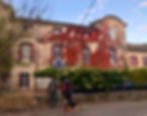Our lives unfold as stories, scenes of seasons, events, places, and people woven into the fabric of our lives. When I think back over my life, I'm amazed at the varied chapters–and that there are so many of them! How did I get to be this age? The number of my years does not match my internal clock. Is that because we are made for eternity?
I love how the French word for history and story is the same: Histoire. And, that's what history is, the story of the past. While it's important to live fully in the present and understand our times, we must not forget the lessons of the past.

I'm continually seeking to understand the histoire of our home and workplace, the Château de Planque. It's an old, old structure, and I can't help but wonder about the people who've lived here through the centuries (yes, centuries!) What can we learn from what they experienced? What are the connections to the stories we're living now?
All this curiosity has led me on a journey to the departmental archives in Nîmes where I was given access to thick parchments with pen and ink writing. The antiquated font, the ink-dipped pen scratchings, and the use of old French (similar to Shakespearean English) made them beyond my ability to decipher. Still, it was incredible to hold them and try to figure out what they said. I can't believe I was allowed to do so! Thankfully, much has been digitalized, and reading old French typed up online is much easier.

The earliest mention I've found for the Château de Planque was in 1444. To save you the mental math, that's 576 years ago! A family named Guiraud de la Planque lived in what was then called the Mas de la Planquette. Mas is the word for farmhouse in the regional language of Occitan, and applies to large structures including a family home and agricultural enterprise.
Later, there are records of eight children in one family, all born here, starting in 1513. They have memorable names: Gabrielle de Guiraud de la Planque is my personal favorite. As a widow, she and her daughter managed the lands and business, improving the all-important water mills of the Planque grounds. They'll definitely appear in the Prequel to my Huguenot Resistance Series.
One of the other interesting past inhabitants is Gabrielle's son, Jean d'Azémar, a "knight of the king." In 1596 his noble fiefdom included: "the Planque house, composed of towers, arrow slits, battlements, with beautiful mills for wheat, olives and wool on the river Vidourle with two big fields stretching as far as the Planque mill, with an olive grove and two gardens plus garrigues and woods. All this joined together , surrounding the said house." Whew! The mills now belong to others, as do the two big fields.

We're #5 on St Hippolyte du Fort's touristic circuit. This sign on the front of the Château explains a bit of our history in four languages.
After Jean d'Azémar's first wife died, he married her sister. Sometime later, their brother ambushed him and murdered him in a land dispute. I couldn't believe my eyes when I stumbled across that information in the archives. The brother-in-law found refuge in a nearby village in Huguenot homes before dying soon after of illness. A sad, dramatic story–about real people and events.
Records show the family was "réformé"–meaning Reformed or what we generally call Protestant. The history of the Château becomes sketchy as the Wars of Religion between French Catholics and Protestants (called Huguenots) erupted and stretched out over a couple of centuries.
In the 1690s, a family called Valmalle acquired the property and fashioned it into a "château." The local historian scoffed when he told me how they pronounced themselves noble by adding the telltale "de" to their name, becoming the de Valmalles de la Planque. Quite the opposite to the practice of hiding one's nobility by dropping the "de" from the family name during the French Revolution to avoid execution.

In the 19th century, the Château was bought by the Bourguet family for their second son, Raoul. I'm privileged to know his great-niece, an incredible woman who lives nearby. Life and light radiate from her, ignited by her faith in Jesus. She'll soon be 90, and I can only hope and aspire to be like her should I live that long. She gifted me with her great-uncle's bible. I treasure the tiny volume, with minuscule inscriptions of favorite verses on the inside cover.



For centuries, the Château has been a place of family life and agricultural enterprises. Twice that we know of, it has been invaded and used as enemy headquarters: first with King Louis XIV's dragoon soldiers sent to suppress Huguenots and more recently in 1944 by SS Nazis seeking young French men evading service in their war effort. There's a rumor that Jewish families were here at some point during WW2. It's unclear if they were captives or taking refuge before fleeing. I hope and pray it was the latter.

"Those who fail to learn from history are condemned to repeat it," is a quote made famous by Winston Churchill, originally attributed to philosopher George Santayana. While our world around us continues to be shaken, stirred, turned upside down and inside out, this seems more important than ever. In this epic season, as we watch the current histoire unfold around us, may we pay close attention to lessons from the past.
Yes, la vie est belle. May we fight to keep it so.

